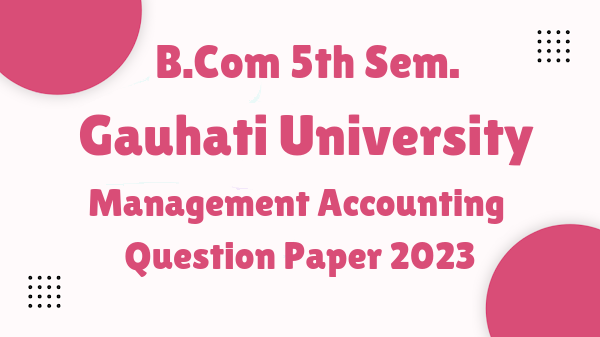On this post we have provided Gauhati University BCom 5th Semester Management Accounting Question Paper 2023 which can be very useful for exam preparation.
GU BCom 5th Sem Management Accounting Question Paper 2023
4 (Sem-5/CBCS) COM НЕ1 (МА)
2023
COMMERCE
(Honours Elective)
Paper: COM-HE-5016
(Management Accounting)
FULL MARKS: 80
1. Answer as directed : 1×10=10
(a) Management Accounting aims at providing decisions to the manageme. (State whether the statement is True or False)
(b) What is Angle of Incidence?
(c)_______ contains many information which are required for effective budgetary planning.
(Fill in the blank)
(d) Trading on equity refers to the use of fixed interest bearing securities by a firm to earn more than their cost so as to increase the return on owners equity.
(State whether the statement is True or False)
(e) _______refers to the ability of a concern to meet its current obligations as and when they become due.
(Fill in the blank)
(f) An unfavourable material price variance occurs when :
(i) there is increase in price of raw materials
(ii) there is decrease in price of raw materials
(iii) wastage is less than anticipated in the manufacturing process
(iv) wastage is more than anticipated in the manufacturing process
(Choose the correct answer)
(g) How is Break-even analysis’ interpreted in its narrower sense?
(h) At break-even point :
(i) there is neither profit nor loss
(ii) total revenue is equal to total costs
(iii) contribution is equal to fixed costs
(iv) All of the above
(Choose the correct answer)
(i) _______budget does not take into consideration any change in expenditure arising out of changes in the level of activity.
(Fill in the blank)
(j) Which of the following transactions will improve the current ratio ?
(i) Purchase of goods for cash
(ii) Payment to trade payables
(iii) Credit purchase of goods
(iv) Collection of cash from trade receivables
(Choose the correct answer)
2. Give brief answers to the following questions : 2×5=10
(a) Mention two managerial uses of ratio analysis.
(b) Write any two characteristic features of management accounting.
(c) What is PV ratio?
(d) What do you mean by Material Pric Variance?
(e) Mention two limitations of Ratio analysis.
3. Answer the following questions : (any four) 5×4=20
(a) Explain briefly the role of a management accountant in a business enterprise.
(b) Describe briefly any five requisites for a successful budgetary control system.
(c) Sale of a company for two consecutive months 3,80,000 and ₹4,20,000. The company’s net profit for these months amounted to ₹24,000 and ₹40,000 respectively. Assuming that there is no any other change, calculate P/V ratio and fixed cost.
(d) Distinguish between Budgetary Control and Standard Costing.
(e) What do you mean by variance analysis? Discuss its importance briefly.
(f) Write any five limitations of Financial Statement analysis.
4. Answer the following questions : (any four)
(a) “The subject of management accounting is very important and useful for optimum utilisation of resources. It is an indispensable discipline for management.” Elucidate this statement. 10
(b) What is meant by Zero-based budgeting? State the advantages and limitations of Zero-based budgeting. 2+4+4=10
(c) Describe briefly the limitations of Financial Accounting and point out how Management Accounting helps in overcoming them. 10
(d) The expenses for the production of 5,000 units of a product in a factory are given as follow:
| Description | Per Unit ₹ |
| Materials | 50.00 |
| Labour | 20.00 |
| Variable factory overheads | 15.00 |
| Fixed factory overheads | 10.00 |
| Administrative expenses (5% variable) | 10.00 |
| Variable selling expenses (80% variable) | 4.80 |
| Fixed distribution expenses (10% fixed) | 0.50 |
The total cost of sales per unit was ₹116.00. You are required to prepare a budget for the production of 8,000 units.
(e) 5+5=10
(i) Given :
Profit ₹200
Sales ₹2,000
Variable Cost 75% of sales Find break-even sales and profit when sales are ₹3,200.
(ii) Given :
Break-even sales ₹8,000
Fixed Costs ₹3,200
Find profit when sales are ₹ 10,000 and sales when profit is ₹2,400.
(f) “Ratio analysis is only a technique for making judgements and not substitute for judgements.” Explain.
(g) From the following particulars find out : 10
(i) Material cost variance
(ii) Material price variance and
(iii) Material usage variance
Quantity of material purchased 3,000 units
Value of material purchased 3 9,000
Standard quantity of material required per tonne of finished product 25 units
Standard rate of material ₹2 per unit
Opening stock of material Nil
Closing stock of material 500 units
Finished production during the year 80 tonnes
(h) 5+5=10
(i) Write an explanatory note on common-size statement.
Given :
Sales ₹3,50,000
Sales returns ₹ 20,000
Gross profit ratio 20%
Inventory turnover ratio 8 times
Opening inventory exceeds closing inventory by ₹ 14,000.
Find opening and closing inventory.
-00000-

